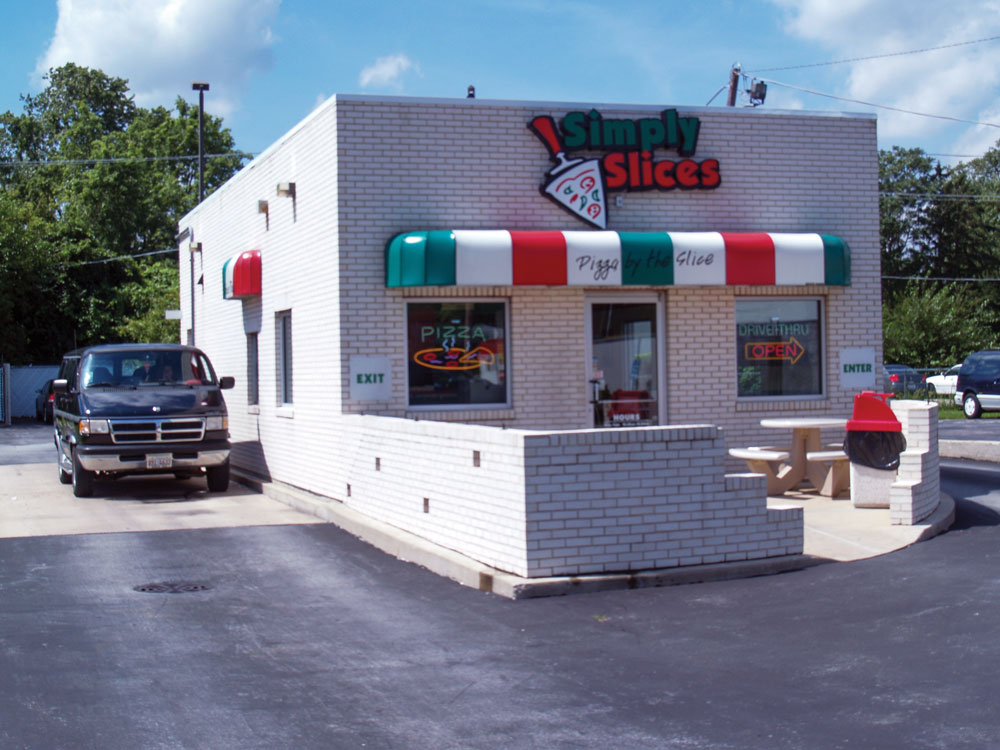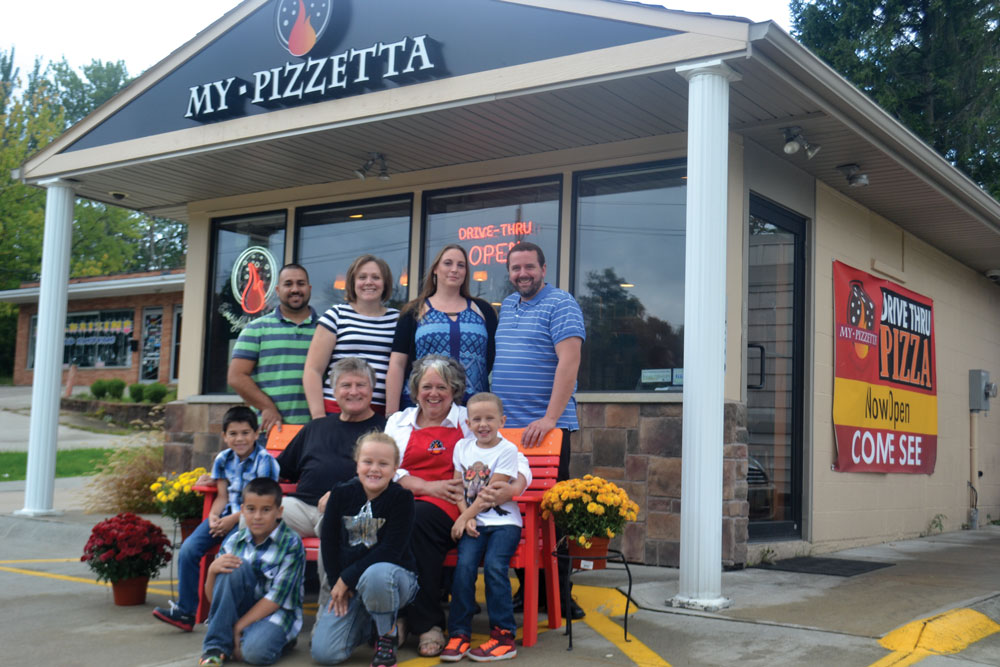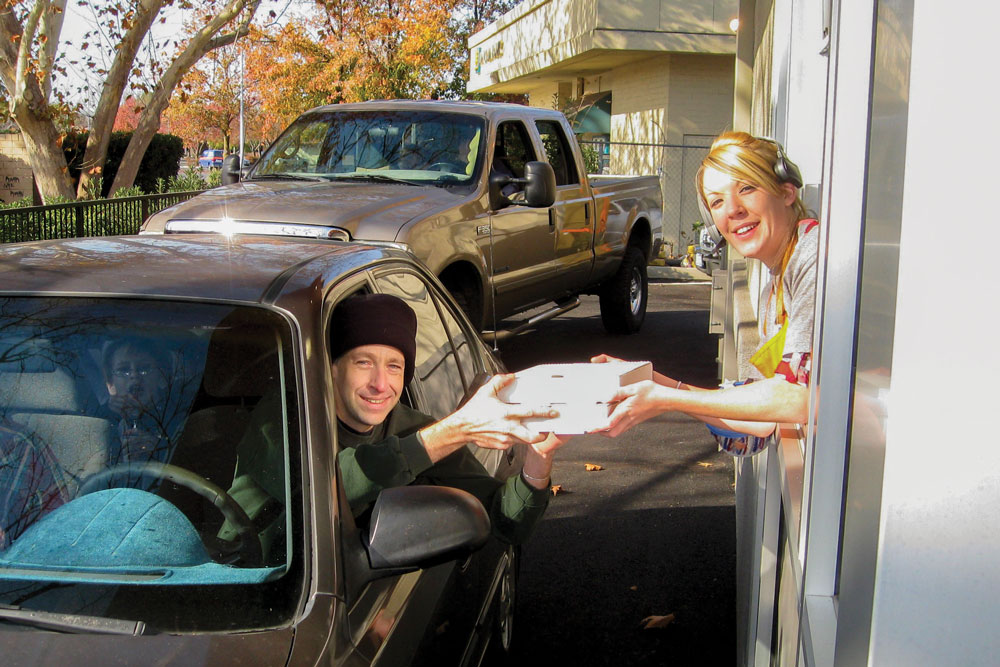While pizzerias have relied on delivery for decades, they’re not often associated with drive-thru service, a market dominated by other types of fast-food fare. Market research company NPD Group reported in 2012 that 12.4 billion visits were made to drive-thrus in the previous year, but most pizzerias shun the option altogether due to the daunting logistics. However, operators with drive-thru pizza shops are changing the game, one location at a time—and many are finding success with a combination of technology, staff training, smart marketing and streamlined service. We tapped their expert tips for how to be successful within this challenging foodservice format.
 |
|
With only 1,000 square feet of space, Dino Pavoni’s Simply Slices entices patrons with customizable slices and pies, value-driven combo deals and an eye-catching logo. |
Exploiting a Niche
Operators of successful drive-thru pizzerias have something in common: They noted a gaping hole in the industry. Aaron Souza, owner of Mad Dash Pizza in Chico, California, couldn’t find anything similar when he wrote his business plan nine years ago. “We thought drive-thru would be great for pizza,” he recalls. “In my mind, it wasn’t offered because of technology—drive-thru needs a fast-serve product—and maybe even laziness. Pizza was also traditionally a group meal, so it dawned on me to do personal pizzas, since a one-size product helps with efficiency and quickness.”
Bob and Sharon Rybak, who run My Pizzetta in North Royalton, Ohio, with their son, Paul, were inspired by quick-cooking wood-fired pies during visits to Italy and had the idea of opening a drive-thru—but they found few pizza-based precedents. “We searched for another place that was strictly drive-thru and couldn’t really find one, so we spent a couple of years working out the logistics,” Paul Rybak says. “Opening with this brand-new concept was a big risk, but people love the product and the convenience.”
Dino Pavoni, owner of Simply Slices, with two locations in Crestwood and Burbank, Illinois, had been running a 99-cent slice business when he noticed long lines at a nearby McDonald’s in 1988, and inspiration struck. “I wanted to revolutionize the pizza and fast-food industries, pioneering a new way for people to look at pizza in that market,” Pavoni recalls. “We decided to do drive-thru pizza by the slice with a small dining area.”
Pavoni recreated the McDonald’s model with pizza, breadsticks and shaved ice and by 1998 had opened up the first drive-thru Simply Slices in Crestwood. “Where was pizza, the most popular food in the country, in the fast-food market?” he asks. “People can call in and pick up a pizza, but they can’t go to a drive-thru and customize a fresh order in minutes, with an attractive price point and high-quality product. I used to offer delivery, but now my customers are doing the driving!”
Besides customer convenience, drive-thrus offer additional benefits, including small footprints. Simply Slices spans 1,000 square feet, staffed by two to three employees. Both Mad Dash and My Pizzetta, which are drive-thru only, take up a mere 600 square feet and, with low rent, have established themselves as pint-size powerhouses.
 |
|
The family-run My Pizzetta enjoyed a significant business boost after a local news station covered its unique drive-thru concept. |
Unique Challenges
When the Rybaks opened My Pizzetta in December 2013, finding the right equipment proved a challenge, but the family painstakingly crafted the menu and the kitchen’s design for maximum efficiency. A gas-fired brick oven bakes made-to-order pies in 90 seconds for an overall service time of three to four minutes. “Opening a drive-thru is a lot more challenging than you would think,” Paul Rybak notes. “It’s a great idea, and it can work, but it has to be fresh and on-point. And it’s something that people aren’t accustomed to, so you have to train both customers and staff.”
Souza designed his shop’s layout to maximize the customer experience and employee efficiency and tinkered with ovens to quickly bake fresh-dough pies. “Initially I purchased par-baked dough, because oven manufacturers told me I couldn’t cook raw dough that fast,” he recalls. “It took a long time to work out the technology side, then figure out how to make the right dough—we had nothing to copy at the time.” Souza believes drive-thru customers won’t wait more than 10 minutes, so he uses multiple ovens to cook pies to order in two minutes and has created a streamlined process, from order taking and pie assembly to processing payment. “We get the pizza made in 30 seconds and cook it in a couple of minutes while the other employees get drinks ready and cash out customers,” Souza says. “You have to make sure there are no bottlenecks.” With experience, Mad Dash has whittled average service time down to three to six minutes.
Pavoni says quick service is essential to reprogramming customers accustomed to sailing through a Burger King drive-thru on their lunch break. “It’s an education process that takes months of patience,” he admits. “It’s critical that your service times stay down and quality stays consistent.”
Fast-casual outlets are helping educate consumers, too, showing that they can get customized pizza, fast. “You have to convince the consumer that it can be done,” Souza says. “That was one of the biggest challenges, but it now has the potential to be less of a challenge as consumers get more comfortable with personalized pizzas.” But customers still need to learn that drive-thru fare doesn’t have to be low-quality and mass-produced. Souza says his customers “freaked out” over the high quality of his pizza. “They already had a perception of what to expect from a drive-thru,” he notes. “They were used to a pizza taking 20 minutes to cook or, if it was fast, they expected it’d be sitting under heat lamps. One thing I hear to this day is that customers just didn’t trust us at first. They thought it couldn’t be quality because it’s quick and drive-thru. We had to prove them wrong.”
 |
|
Mad Dash’s “California cool” design, premium personal pies and fast, convenient service have led to 20% to 30% year-over-year growth in a 600-square-foot space. |
Secrets of Success
Great locations, jazzy logos and well-placed signage are all important for drive-thru locations. “Your signage is going to market you,” Pavoni says. “I did radio, print and direct mail, but nine out of 10 customers say they just saw our sign on the street. You need a logo that attracts people’s attention—then you need to have a quality product.”
A location on one of the highest-traffic corners in town, next to a popular coffee drive-thru, also helped increase visibility for Mad Dash. Its “California cool” vibe, with a colorful logo and design, helped attract early customers, from whom Souza solicited feedback for the first couple of years to perfect his concept. After opening, he focused on speed but soon realized customers were more interested in quality, which changed everything from marketing to menu boards (for example, he decided to push premium pizzas). He keeps the menu simple, constantly evaluating the most popular orders to determine the images pictured on his menu board. “The entirety of the concept has to work, from location, branding and messaging to product quality, customer service and menu boards,” he says.
Media coverage helped My Pizzetta take off, Rybak says. Within six months of opening, a local news station profiled the unique concept on TV, spurring visitors from up to 50 miles away. “We explain to customers what we do—make everything fresh in-store—and are very transparent about our product,” he says. “Our Facebook page explains what’s in our products, and they know we’re making everything to order. We even invite customers into the kitchen to show them the process.”
Menu simplicity is important for operational efficiency, but customers still demand variety. Simply Slices offers customizable full pies and slices (including a gluten-free crust), appetizers and combo deals, like two slices and a drink. My Pizzetta offers three crusts (including gluten- free), nine sauces and dozens of cheese, meat and veggie toppings—all arranged with a number system that allows regular customers to quickly call out their go-to faves.
And, with the kinks worked out, operators find that word-of-mouth has been crucial. Souza, after a tough first year, now enjoys 20% to 30% year-over-year growth. Both Pavoni and Souza are fielding calls from interested franchisees and looking to expand further. My Pizzetta, meanwhile, stays involved with local schools and has marketed on radio, in print, with Groupon and on local grocery store carts, but the best advertisement has come through face-to-face contact. “Being in a smaller place, you have to put yourself out there,” Rybak says. “We’d make small pizzas and take them to local businesses, which helped build our base. We ask first-time customers how they heard about us, and a lot of our new business comes from word-of-mouth.”
By all accounts, drive-thru formats are fraught with challenges, but inventive operators are cashing in on this calculated risk. “If someone’s going to do a drive-thru, they have to commit and look at it with fresh eyes, because it’s such a different beast,” Souza concludes. “At McDonald’s or Burger King, customers know what they’re getting—but a pizza place with this concept has to prove itself every day.”













